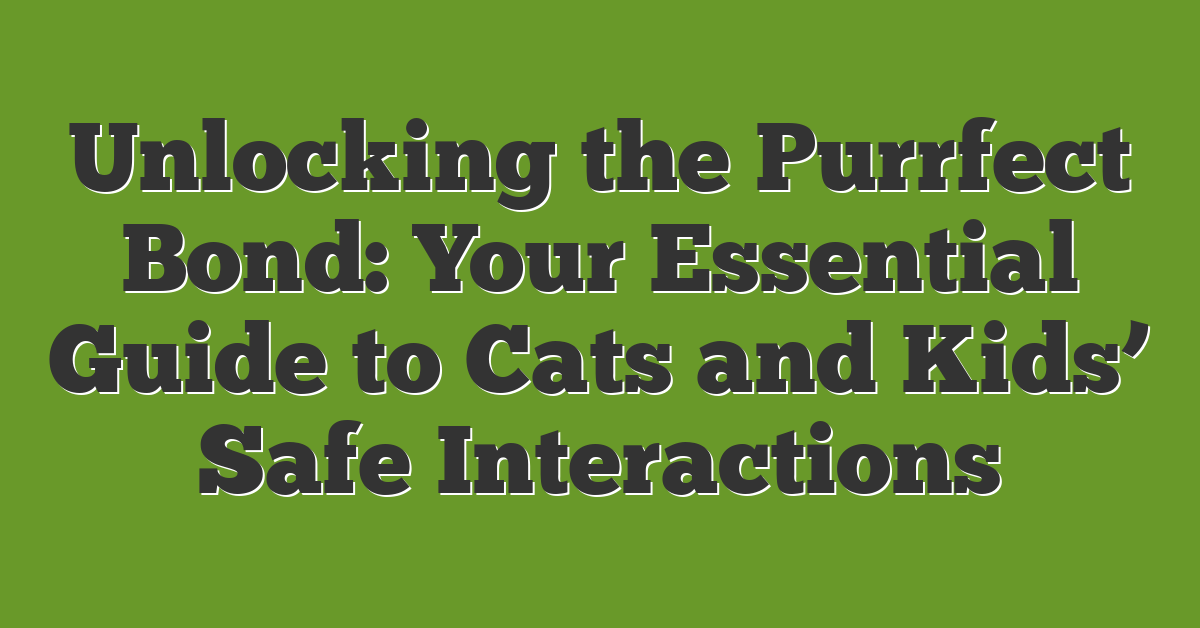As a cat lover and a parent, I know how magical the bond between kids and cats can be. Watching my little ones interact with our furry friends brings joy to my heart. However, it’s crucial to ensure those interactions are safe and positive for both parties.

Teaching kids how to interact with cats is more than just fun; it’s about fostering respect and understanding for animals. With the right guidance, children can learn to appreciate the unique personalities of cats while keeping everyone safe. In this article, I’ll share some practical tips and insights on nurturing that special relationship.
Understanding Cats and Kids
Understanding the relationship between cats and kids is essential for creating a safe and fun environment. Cats can bring joy to a child’s life. Kids must learn how to interact with them safely.
Importance of Safe Interactions
Safe interactions prevent accidents. They protect both kids and cats. Teaching kids to approach cats gently helps build trust. Kids must learn to recognize when a cat wants space. Signs like hissing or swatting indicate a need for distance. Encouraging calm behavior fosters positive experiences and keeps everyone happy.
Common Myths About Cats and Kids
Many myths surround cats and kids. One myth is that cats are naturally unfriendly. In reality, cats can be loving companions. They often enjoy being petted and playing with kids. Another myth is that all cats dislike loud noises. Certain cats adapt well to active households but may prefer quieter moments. Understanding these myths helps kids appreciate their feline friends better.
Preparing Your Home
Creating a safe environment for both kids and cats fosters positive interactions. Planning this setting helps prevent accidents and stress.
Creating a Safe Space for Cats
I set aside quiet areas for my cat. These spots help her feel secure. They can include soft beds or cozy corners away from the main activity. I provide hiding places, like cat tunnels or boxes, so she can escape if needed. Avoid placing litter boxes near these safe spaces to maintain cleanliness and comfort.
Kid-Friendly Areas for Interaction
I create dedicated areas for kids to interact with my cat. These spots should encourage gentle play. I use durable toys that won’t break easily. I teach kids to sit on the floor when playing. This way, my cat feels less threatened. Always supervise their interactions to guide them on gentle touches. It’s essential to explain signs of stress in cats, like sudden movements or tail twitching.
Teaching Kids About Cats
Teaching kids about cats builds a strong bond. It creates a safe environment for both kids and their feline friends.
Recognizing Feline Body Language
Cats communicate through body language. I teach kids to look for signs.
- Tail position: A high tail means a happy cat. A low or puffed tail indicates fear or aggression.
- Ears: Forward ears show curiosity. Flattened ears signal annoyance or fear.
- Eyes: Slow blinking means trust. Wide eyes can show surprise or fear.
- Purring: It often means contentment, but it can also signal discomfort. Teach kids to observe the context.
Kids learn to recognize these signals. Understanding feline body language helps them know when to approach or give space.
Basic Rules for Interacting with Cats
Clear rules guide safe interactions. I emphasize simple guidelines.
- Approach slowly: Kids should walk quietly and avoid sudden movements. This gives cats a chance to feel safe.
- Let the cat initiate: Encourage kids to wait for the cat to come to them. It helps build a trusting relationship.
- Gentle touches: Teach kids to use gentle hands. Patting tops of the head or backs is usually safe.
- Avoid the whiskers and tail: Remind kids that these areas can be sensitive.
- Respect their space: If a cat walks away, it’s a sign they need time alone. Kids should not chase them.
These rules keep interactions positive. They teach respect for the cat’s feelings and comfort zones.
Supervised Activities
Supervised activities create a safe space for interactions between kids and cats. They ensure both enjoy their time together while minimizing risks.
Interactive Playtime Ideas
Interactive play strengthens the bond between kids and cats. I recommend using feather wands, laser pointers, or soft balls. Each toy engages the cat, encouraging active play. Kids can take turns moving the toys, allowing the cat to chase and pounce. Watching a cat leap and play excites children while teaching them about gentle handling. Always supervise to ensure the cat stays comfortable during play.
Safe Handling Techniques
Teaching safe handling techniques is crucial. Kids should learn to approach cats calmly. I suggest showing them to extend a hand slowly, letting the cat sniff first. This helps the cat feel secure. Encourage gentle strokes along the cat’s back. Avoid the face and tail, as many cats dislike those areas being touched. If a cat shows signs of stress, like twitching ears or a swishing tail, kids should back off.
Using these techniques helps kids learn respect for their feline friends.
Conclusion
Creating a safe and loving environment for both kids and cats is truly rewarding. By teaching children how to interact gently and respectfully with their feline friends, we’re nurturing a bond that can last a lifetime. It’s all about patience and understanding.
I’ve found that these moments of connection not only enrich our lives but also help kids learn empathy and responsibility. With a little guidance and supervision, we can ensure that every interaction is a positive experience. So let’s keep fostering that special relationship between our kids and their furry companions. It’s a journey worth taking together.
















